Pay Once and Have Free Attractions Entry for 2, 3, 5 or 7 days
A symbol of religious harmony, artistic brilliance, and historical significance, Hagia Sophia is a must-see attraction for anyone visiting Istanbul. As a UNESCO World Heritage Site, this architectural wonder has been an iconic part of the city’s skyline for centuries, witnessing the rise and fall of empires and the ebb and flow of faiths.
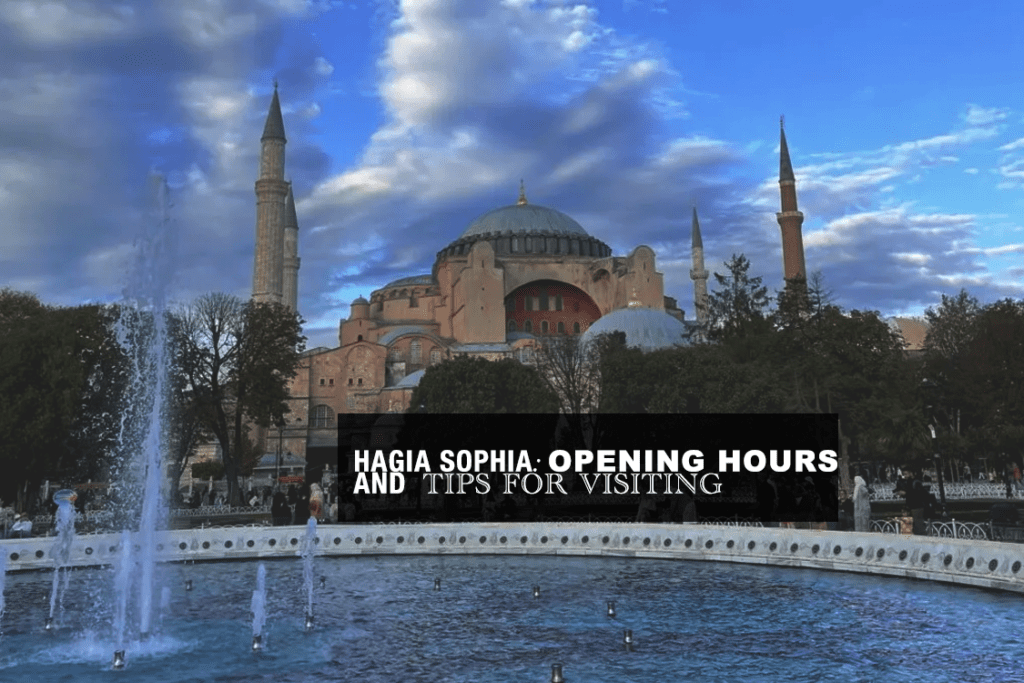
New Visiting Rules and Museum Exposition at Hagia Sophia
If you’re planning a visit to the iconic Hagia Sophia in Istanbul in 2024, there are some important updates you should be aware of.
Two Separate Entries: One for Turkish Muslim Citizens and Another for Tourists
Starting from January 15, 2024, Hagia Sophia has implemented a new visiting system. This system differentiates between Turkish Muslim citizens and tourists. Here’s what you need to know:
- Turkish Citizens: The main floor of Hagia Sophia is now reserved exclusively for prayers. Turkish citizens can access this area for namaz (prayer) and religious activities. It’s a space where the sanctity of the mosque is upheld.
- Tourists: Tourists who wish to explore Hagia Sophia must purchase a ticket. The ticket price is 850 TL or €25. With your ticket, you’ll have access to the parts of Hagia Sophia designated for tourists, including the gallery floor.
For the Best Experience, Book Hagia Sophia Tickets and Tours with GetYourGuide
To ensure an unforgettable journey, secure your tickets through GetYourGuide and Tours for hassle-free access to the world’s most iconic attractions:
Istanbul: Hagia Sophia Tour and Experience Museum Tickets (visit the Hagia Sophia History & Experience Museum)
Istanbul: Hagia Sophia, Suleymaniye and Blue Mosque Tour (the most Iconic Mosques)
Istanbul: Blue Mosque, Basilica Cistern & Hagia Sophia Tour (All of the Best in One)
No Guides Inside the Mosque: Audioguide for a More Personal Experience
Upon entering Hagia Sophia, you can use the provided headset system with a QR code application. This technology allows you to receive detailed information about the mosque in 23 languages. Whether you prefer to use your mobile phone headset or the disposable headsets provided, this system ensures that the tranquility of worshipers is not disturbed.
The Gallery Floor is Open: A Window to History and Spirituality
The highlight of this new system is the guided tour to the gallery floor. This elevated section of Hagia Sophia, historically used to house the empress and her court during services, now serves as a vantage point for visitors to gaze uponthe mosque’s sanctuary floor and the Ottoman period annexes. This architectural journey not only showcases the mosque’s grandeur but also its rich historical tapestry.
The Heaven-Hell Gate and Byzantine Mosaics
One of the most intriguing aspects of the tour is the passage through the “Heaven-Hell Gate.” This symbolic doorway, steeped in historical and religious significance, offers a unique perspective on the Byzantine era. In this section, visitors will have the opportunity to closely examine the intricate Byzantine period mosaics, a testament to the artistic mastery and spiritual narratives of the time.
Don’t Miss The Best Tours and Cruises in Istanbul
What to Else See in Hagia Sophia in Istanbul?
Exterior Features: Grandeur on Display
The Grand Dome
Dominating the cityscape, Hagia Sophia’s grand dome stretches 102 feet in diameter and soars to a height of 180 feet, showcasing the prowess of Byzantine engineering. Supported by four massive pendentives, this remarkable structure seamlessly blends the square base with the circular dome, creating an awe-inspiring sight.
The Minarets
Four minarets, each of different height and style, majestically rise from the corners of Hagia Sophia. These elegant structures were added during the Ottoman period and remain a striking example of Islamic architecture.
Exploring the Upper Gallery of Hagia Sophia
The Grave Marker of Commander Enrico Dandolo
In the upper gallery of Hagia Sophia, visitors will encounter the grave marker of Commander Enrico Dandolo, Doge of Venice. Dandolo, a pivotal figure in the 4th Crusade, passed away in Istanbul in 1205. This historical marker stands opposite the Deesis mosaic, offering a glimpse into the complex interplay of European and Byzantine histories that have left their marks on this iconic structure.
Viking Inscription at Hagia Sophia
A fascinating aspect of Hagia Sophia’s history is found in its Viking inscription. Etched into the marble parapets in the south gallery, the phrase “Halvdan was here” dates back to the 9th century. This inscription is believed to have been made by a Viking mercenary serving in the Byzantine army. This unexpected piece of history hints at the possibility of more such runic inscriptions from the Viking age hidden within the mosque.
The Lustration Urns
In the upper gallery, visitors will also see the Great Marble Urns, monumental artifacts from the Hellenistic Period (330-30 BC). Originally from the ancient city of Pergamon (Bergama), these urns were brought to Hagia Sophia during the reign of Sultan Murad III (1574-1595). Historically used for distributing sherbet on holy nights and after ‘Eid prayers, these urns, capable of holding about 1250 liters, now stand as silent witnesses to centuries of religious ceremonies.
The Omphalion
The Omphalion is another significant feature in Hagia Sophia. This area, marked by marble circles of varying sizes and colors, was where Byzantine emperors were crowned. The large central marble circle surrounded by smaller ones symbolizes the centrality and sanctity of the imperial power during the Byzantine Empire.
The Dome (Qubbah)
The main dome of Hagia Sophia, standing 55.6 meters tall with a diameter of approximately 32 meters, is a marvel of architectural design. Originally built flat, it was later raised to its current shape, with the final form credited to Mimar Sinan (Sinan the Architect). In Turkish-Islamic architecture, the dome symbolizes the heavens and the oneness of Allah. The dome of Hagia Sophia Mosque is adorned with a verse from the Qur’an, beautifully calligraphed by Kazasker Mustafa Izzet Efendi, one of the most esteemed calligraphers of Sultan Abdulmejid’s reign.
This verse, “Allah is the Light of the heavens and the earth…” (Nur, 24/35), captures the spiritual essence of the mosque, harmonizing the architectural grandeur with its religious significance.
Interior Design of Hagia Sophia: A Tapestry of Time
Mosaics and Frescoes
The interior of Hagia Sophia is adorned with intricate mosaics and frescoes that narrate the stories of Christianity and Islam. These exquisite works of art, some dating back to the 6th century, depict biblical scenes, imperial figures, and religious symbols, reflecting the rich history of the building.
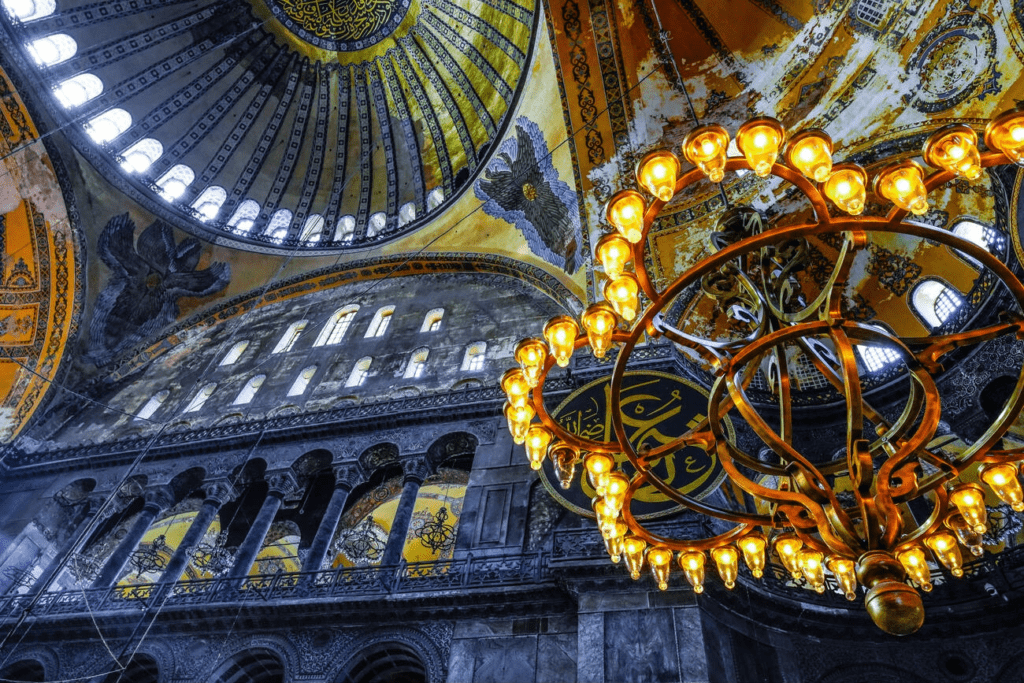
Calligraphy and Islamic Elements

In addition to the Christian artwork, Hagia Sophia features stunning calligraphic panels and Islamic elements. The Arabic inscriptions on the walls and the giant medallions bearing the names of Allah, the Prophet Muhammad, and the first four caliphs, showcase the harmony between the two faiths within this sacred space.
The Mihrab and Muezzin’s Lodge
As a functional mosque, Hagia Sophia houses a beautifully crafted mihrab, which denotes the direction of Mecca for prayers. Adjacent to the mihrab is the muezzin’s lodge, where the call to prayer is delivered.
Istanbul E-Pass: Enjoy a Free Guided Tour of Hagia Sophia
The Istanbul E-Pass offers a convenient and cost-effective way to explore the city and make the most of your visit to Hagia Sophia. One of the key benefits of the E-Pass is that it includes a free guided tour of Hagia Sophia, allowing you to delve deeper into its history and architectural marvels with the help of a knowledgeable guide.
In addition to the complimentary Hagia Sophia tour, the Istanbul E-Pass grants you access to over 50 other attractions across the city. This means you can explore Istanbul’s rich history and culture at your own pace without worrying about purchasing individual tickets for each site.
Visiting Hagia Sophia: A Memorable Experience
Hagia Sophia Opening Hours 2024
As for 2024, Hagia Sophia for tourists is open every day.
Hagia Sophia Museum Part is open to visitors every day, with the following visiting hours: from 09:00 to 19:30. Box office is open until 19:00.
As for 2024, Hagia Sophia for prayers is open every day. Earlier it was closed on Mondays.
Hagia Sophia is open to visitors every day, with the following visiting hours:
- Monday, Tuesday, Wednesday, Thursday, Saturday, Sunday: 9:00 AM – 11:00 PM
- Fridays: 14:30 AM – 11:00 PM.
For the Best Experience, Book Hagia Sophia Tickets and Tours with GetYourGuide
To ensure an unforgettable journey, secure your tickets through GetYourGuide and Tours for hassle-free access to the world’s most iconic attractions:
Istanbul: Hagia Sophia Tour and Experience Museum Tickets (visit the Hagia Sophia History & Experience Museum)
Istanbul: Hagia Sophia, Suleymaniye and Blue Mosque Tour (the most Iconic Mosques)
Istanbul: Blue Mosque, Basilica Cistern & Hagia Sophia Tour (All of the Best in One)
Please note that Hagia Sophia is still closed for tourists during prayer times (they are different every day depending on the daytime). You can check it here.
Note: You can find info on the internet that Hagia Sophia is open on Fridays. We checked, and as of 2024, Hagia Sophia is open on Fridays, but only from 14:30 to 23:00. It is open from 09:00 to 14:30 only for Turkish citizens. Please note this if you plan to visit.
Hagia Sophia Entrance Fee 2024
As of January 15, 2024, visitors to the Hagia Sophia in Istanbul will need to purchase a ticket to gain entry. The new ticket price is set at 25€ or 850 Turkish Lira.
Starting from January 15, 2024, there will be a significant change for foreign tourists planning to explore the wonders of Hagia Sophia in Istanbul. Unlike in the past, there will now be an entrance fee for foreign visitors. This adjustment doesn’t apply to citizens visiting for religious purposes, as their entry will remain free of charge.
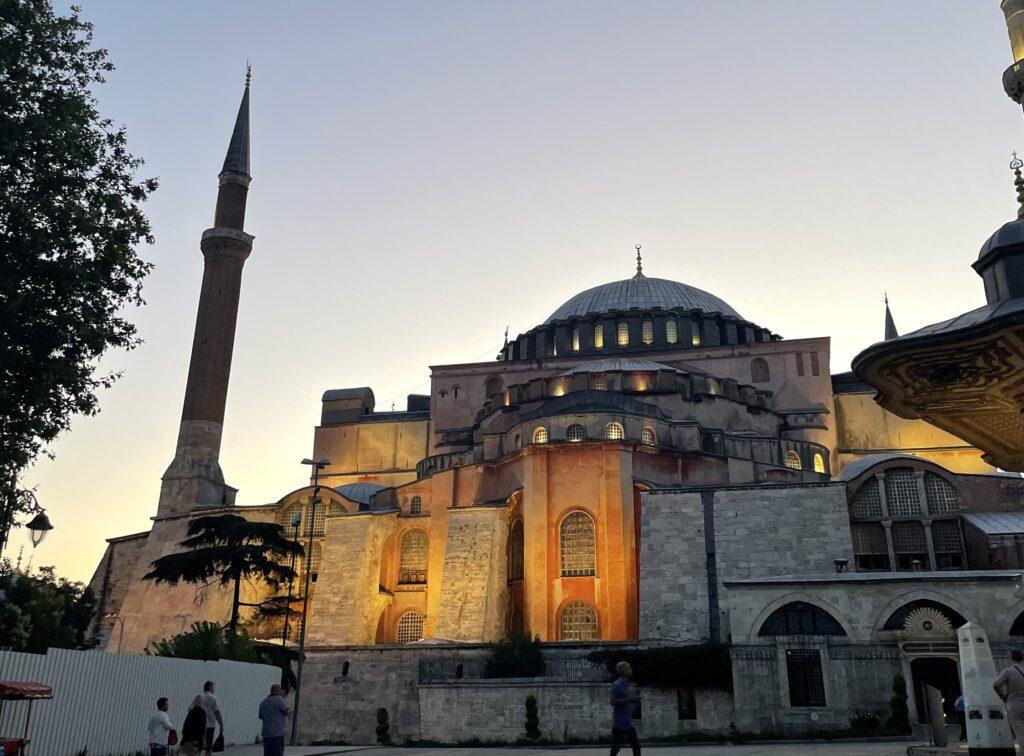
How to Get to Hagia Sophia 2024?
Hagia Sophia is located in the historic Sultanahmet district of Istanbul, Turkey. See the location…
From Old City hotels: Take the T1 tram to the Sultanahmet tram station. From there, it’s just a 5-minute walk to Hagia Sophia.
From Taksim hotels: Start at Taksim Square and take the F1 funicular line to Kabataş. From Kabataş, board the T1 tram to Sultanahmet tram station. The Hagia Sophia is a 2-3 minute walk from the tram station.
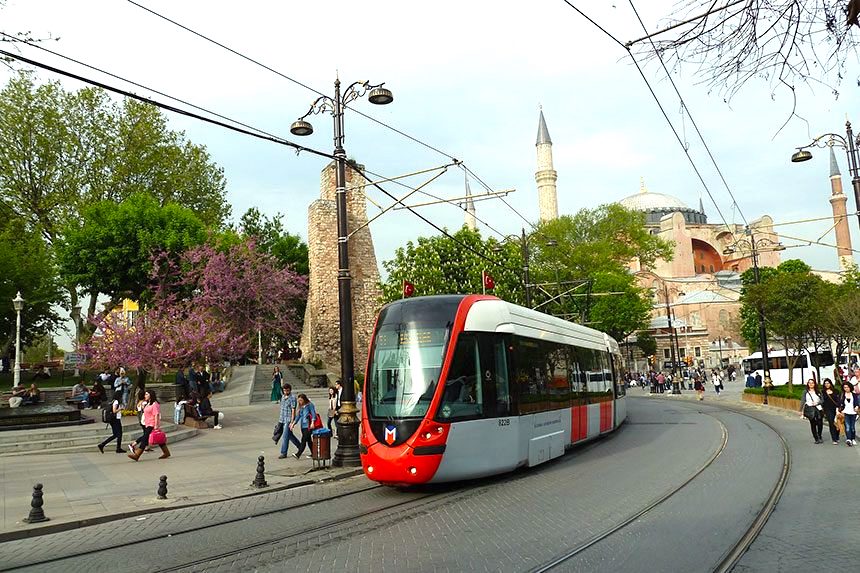
From Sultanahmet hotels: If you’re staying in the Sultanahmet area, Hagia Sophia is likely within walking distance from your hotel.
Also Read: Transport for Tourists in Istanbul: the Main Routes of Tram, Metro, Funicular and Ferry
Tips for Visiting Hagia Sophia: Making the Most of Your Experience
Best Times to Visit Hagia Sophia
To avoid crowds, it is best to visit Hagia Sophia early in the morning or late in the afternoon (the best time is about 2 hours before closing). The months of April, May, September, and October offer milder weather and fewer tourists, making them ideal times to explore this historic site. Since Hagia Sophia is currently functioning as a mosque, it is essential to be mindful of prayer times when planning your visit.
Not sure when is the best time to visit Istanbul? Read our guide.
How long does it take to visit Hagia Sophia and what is the best time?
Exploring Hagia Sophia on your own typically takes between 30 to 45 minutes, while guided tours can last around 1 to 1.5 hours. The building is filled with intricate details and fascinating history worth discovering.
What to Wear and Bring to Hagia Sophia
As Hagia Sophia is an active mosque, visitors should dress modestly. Women should cover their hair with a scarf, and both men and women should wear clothing that covers their shoulders and knees. A lightweight shawl or pashmina can be useful for covering up when necessary. Comfortable shoes are recommended, as the marble floors can be slippery.
Photography Etiquette
Photography is allowed inside Hagia Sophia, but tripods, monopods, and selfie sticks are not permitted. Be respectful of worshippers and avoid using flash photography during prayer times.
Historian Guided Tours: Unveiling the Secrets of Hagia Sophia
A guided tour led by a historian can provide invaluable insights into Hagia Sophia’s architecture, history, and cultural significance! Don’t miss the opportunity to learn more about this historical suite:
A Journey Through Hagia Sophia’s Rich History
The Byzantine Period: A Testament to Faith and Power
Commissioned by Emperor Justinian I in 537 AD, Hagia Sophia was built as a grand cathedral, symbolizing the might of the Byzantine Empire. Renowned architects Anthemius of Tralles and Isidore of Miletus designed this architectural marvel, which served as the primary church of the Eastern Orthodox Church for over 900 years.
Hagia Sophia played a pivotal role in the religious life of the Byzantine Empire, hosting imperial coronations, religious ceremonies, and serving as the seat of the Eastern Orthodox Patriarchate.
The Ottoman Period: An Era of Transformation
The Conquest of Constantinople
With the conquest of Constantinople by the Ottoman Empire in 1453, Hagia Sophia’s fate changed dramatically. Sultan Mehmed II ordered the conversion of the cathedral into a mosque, and the once Christian stronghold became a symbol of Islamic triumph.
Conversion into a Mosque
During the conversion, many Christian symbols and mosaics were covered or removed to adhere to Islamic religious requirements. The addition of minarets, a mihrab, and a minbar transformed Hagia Sophia’s appearance and established its new function as a place of Islamic worship.
The Library of Sultan Mahmud I
In 1739, Sultan Mahmud I constructed a library within Hagia Sophia’s grounds. This addition reflects the Ottoman Empire’s appreciation for knowledge and the arts, further enriching the site’s cultural significance.
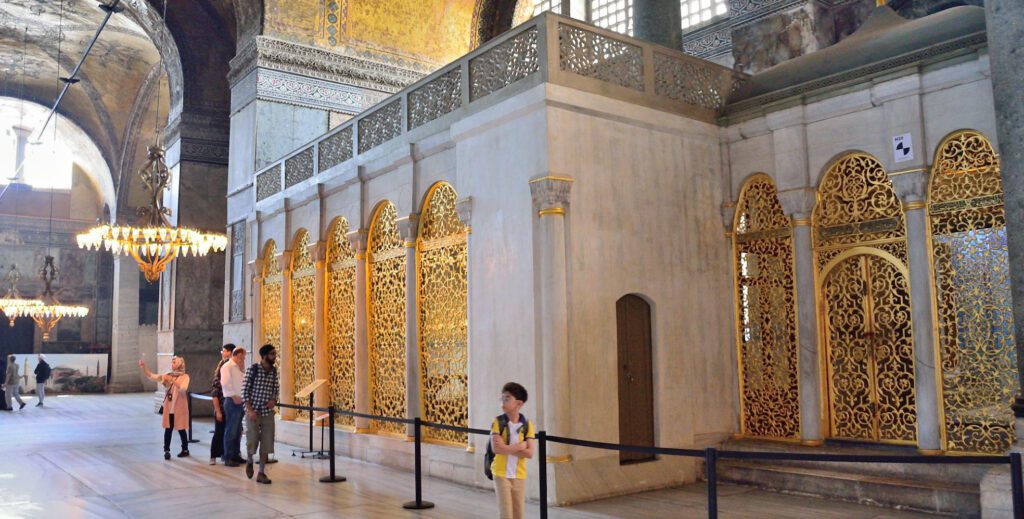
The Modern History of the Hagia Sophia: A Symbol of Unity
Transformation Hagia Sophia into a Museum
In 1935, under the leadership of Mustafa Kemal Atatürk, Hagia Sophia was secularized and converted into a museum, allowing visitors from around the world to marvel at its architectural and artistic treasures.
Reconversion Hagia Sophia into a Mosque
In a controversial decision in 2020, Turkey’s government declared Hagia Sophia a mosque once more. Today, the site serves as both a place of worship and a historic monument, embodying the complex interplay of faiths and cultures that have shaped its history.
The Spiritual Experience of the Hagia Sophia
Prayer Times and Worship at Hagia Sophia
As an active mosque, Hagia Sophia holds regular prayer sessions, which are open to Muslim worshippers. Non-Muslim visitors are asked to wait outside during prayer times, respecting the sanctity of the site.

The Harmony of Christianity and Islam
Hagia Sophia’s unique blend of Christian and Islamic elements is a testament to the enduring power of interfaith dialogue and understanding. As you explore the site, you’ll find Christian mosaics juxtaposed with Islamic calligraphy, exemplifying the harmonious coexistence of the two faiths throughout Hagia Sophia’s history.
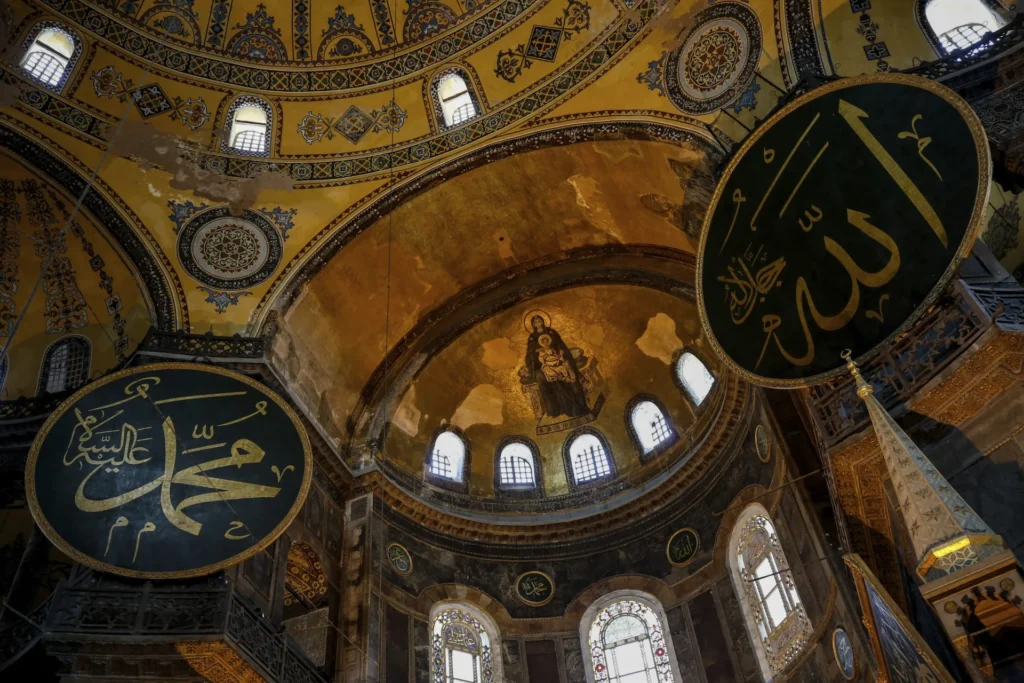
Nearby Attractions and Experiences: Discover Istanbul’s Rich Heritage
While visiting Hagia Sophia, don’t miss the opportunity to explore other nearby attractions that showcase Istanbul’s rich cultural and historical legacy:
Blue Mosque
Just a short walk from Hagia Sophia, the Blue Mosque is renowned for its stunning blue Iznik tiles and six minarets. A masterpiece of Ottoman architecture, it remains an active place of worship today. Read more…
Topkapi Palace
The opulent Topkapi Palace served as the main residence of the Ottoman sultans for nearly 400 years. Today, it houses a museum showcasing exquisitecollections of art, jewels, and artifacts from the Ottoman Empire. Read more…
Basilica Cistern
This ancient underground cistern, built during the reign of Emperor Justinian I, features 336 marble columns and a mysterious atmosphere. Discover the eerie beauty of this historic site, which once supplied water to the Great Palace of Constantinople. Read more…
Grand Bazaar
One of the world’s oldest and largest covered markets, the Grand Bazaar is a treasure trove of shops, cafés, and vibrant energy. Find souvenirs, spices, textiles, and much more as you wander through its labyrinthine corridors. Read more…
Istanbul Archaeological Museums
This complex of three museums houses an extensive collection of artifacts spanning various periods and civilizations, including ancient Egypt, Mesopotamia, and the Ottoman Empire. Read more…
Where to Stay Near Hagia Sophia: Luxurious Comfort and Convenience
Boutique Saint Sophia Hotel Istanbul
Booking.comLocated close to Hagia Sophia, this boutique hotel offers a bar, stunning views of the historic site, and modern, chic rooms. The hotel’s warm and welcoming staff ensures a comfortable stay, while its central location makes it an ideal base for exploring the city’s main attractions.
Hagia Sofia Mansions Istanbul, Curio Collection by Hilton
Booking.comIndulge in luxury at this hotel, featuring Ottoman-style suites, a pool, and a fitness center. The Hagia Sofia Mansions provide guests with an authentic experience of Istanbul’s rich history and culture, with beautifully restored rooms and suites that boast unique design elements and modern amenities.
The Million Stone Hotel
Booking.comFor a more budget-friendly option, this cozy hotel offers a sauna and a warm, welcoming atmosphere. The Million Stone Hotel combines traditional Turkish hospitality with contemporary comforts to provide guests with a memorable stay. Its proximity to Hagia Sophia and other major attractions makes it a convenient choice for travelers.
Where to Eat Near Hagia Sophia: Culinary Delights Amidst History
Matbah Restaurant
Sample historic Turkish recipes, such as lamb, rabbit, and baklava, in this elegant restaurant, offering great views of Hagia Sophia. The ambiance of Matbah Restaurant transports you back in time, with its ornate decor and warm lighting. The attentive staff and extensive menu make it a must-visit dining experience while in Istanbul. See the location…
360 Panorama Restaurant
Experience panoramic views of Istanbul while enjoying a modern culinary experience in this stylish venue. The 360 Panorama Restaurant offers a fusion of traditional Turkish and international cuisine, served in a sophisticated setting. With its breathtaking vistas and inventive menu, this restaurant is perfect for a special night out or a memorable meal with friends and family. See the location…
Ayasofya Kebap House
Savor traditional kebap and other street food favorites at this popular, casual eatery near Hagia Sophia. The Ayasofya Kebap House offers a laid-back atmosphere, where locals and tourists alike can enjoy authentic Turkish flavors. Its friendly staff and delicious, affordable menu make it an ideal spot for a quick bite or a leisurely meal. See the location…
Conclusion: The Enduring Legacy of Hagia Sophia
As you explore the majestic Hagia Sophia, you’ll be immersed in its enduring legacy and its role in fostering interfaith understanding and dialogue. Whether admiring its magnificent architecture or learning about its fascinating history, a visit to Hagia Sophia promises to be an unforgettable experience.
Visitor Information
-
💵
Entrance Fee: €25
-
⛔
Closed: Mondays
-
📍
Location: Sultan Ahmet, Ayasofya Meydanı No:1, 34122 Fatih/İstanbul
⌛ Opening Hours: April to October: 9:00 AM – 7:00 PM (last entrance at 6:00 PM); November to March: 9:00 AM – 5:00 PM (last entrance at 4:00 PM)
Frequently Asked Questions
Q: Why is Hagia Sophia famous?
A: Hagia Sophia is famous for its grand architecture, rich history, and cultural significance. It has served as a cathedral, mosque, and museum throughout its existence, symbolizing the intersection of Christianity and Islam.
Q: Where is Hagia Sophia located?
A: Hagia Sophia is located in the historic Sultanahmet district of Istanbul, Turkey.
Q: Which religion does Hagia Sophia belong to?
A: Hagia Sophia was originally a Christian cathedral, later converted into a mosque, and now serves as a mosque once again. It represents both Christianity and Islam.
Q: Who built Hagia Sophia Istanbul?
A: Emperor Justinian I of the Byzantine Empire commissioned the construction of Hagia Sophia in 537 AD.
Q: What is the dress code to visit Hagia Sophia?
A: Visitors should dress modestly, covering their shoulders and knees. Women may be required to cover their hair with a scarf.
Q: Is it “Aya Sophia” or “Hagia Sophia”?
A: Both names refer to the same historic building. “Hagia Sophia” is the Greek name, while “Aya Sophia” is the Turkish version.
Q: What is the difference between the Blue Mosque and Hagia Sophia?
A: The Blue Mosque is an active mosque built during the Ottoman Empire, while Hagia Sophia is a former cathedral and mosque that has served as both a museum and a mosque throughout its history.
Q: Hagia Sophia is a church or a mosque?
A: Hagia Sophia has functioned as both a church and a mosque. It was originally a Christian cathedral, later converted into a mosque, and currently serves as a mosque.
Q: Who is buried in Hagia Sophia?
A: Several prominent figures are buried in Hagia Sophia, including Byzantine emperors and Ottoman sultans.
Q: Are tourists allowed to visit Hagia Sophia?
A: Yes, tourists are allowed to visit Hagia Sophia, but they must adhere to specific visiting hours and follow the dress code.
Q: When was Hagia Sophia built?
A: Hagia Sophia was built in 537 AD under the orders of Emperor Justinian I.
Q: What is the definition of Hagia Sophia?
A: Hagia Sophia, meaning “Holy Wisdom” in Greek, is a historic building in Istanbul, Turkey, that has served as a cathedral, mosque, and museum throughout its existence.
Q: Is Hagia Sophia free?
A: No, there is an entrance fee for visiting Hagia Sophia.
Q: What is Hagia Sophia used for today?
A: Hagia Sophia is currently used as a mosque and is also open to tourists for visiting during specified hours.
Q: How long does it take to visit the Hagia Sophia and what is the best time?
A: It takes approximately 1-2 hours to visit Hagia Sophia. The best time to visit is during weekdays and early mornings to avoid large crowds.
Q: Where is the Hagia Sophia located?
A: Hagia Sophia is located in the Sultanahmet district of Istanbul, Turkey.
Q: What time does Hagia Sophia open?
A: Hagia Sophia opens at 9 am and closes at 5 pm, except for prayer times, when it closes to visitors. Please check the official website for the most up-to-date information on visiting hours.
Q: What does Hagia Sophia mean in Greek?
Hagia Sophia means “Holy Wisdom” in Greek.
Q: How do you pronounce Hagia Sophia?
Hagia Sophia is pronounced as “Hah-gee-ah Soh-fee-ah” in English.
Q: Is Hagia Sophia open?
Yes, Hagia Sophia is open to visitors. However, it is closed during Muslim prayer times on Fridays, and non-Muslim visitors are asked to wait outside.
You Might Be Interested in
- Best Food Delivery Apps in Istanbul: How to Order Food In
- Istanbul in May: Weather & Things to Do, Events in 2024
- April Weather in Istanbul: The Ultimate Guide for Travelers (2024)
- How to Make Turkish Coffee: Step-by-Step Recipe
- Explore Maltepe in Istanbul (Asian Side): Things to Do & See, Hotels, Restaurants (2024)
- Traveling in Istanbul with a Baby: Places to See and Tips for a Pleasant Vacation
- Istanbul Ruines and Constantinopol Sites: A Journey Through Byzantine History
- Galata Tower in Istanbul: Entrance Fee, Opening Hours, History & What to See (2024)
- Istanbul Archaeological Museums: Museums, Tickets, Opening Hours (2024)
- 8 Best Taksim Square Hotels in Istanbul from Luxury to Budget (2024)
Don’t Miss The Best Tours and Cruises in Istanbul